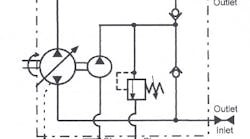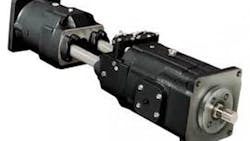The charge pump on a closed-circuit, hydrostatic transmission (HST) has a number of important functions. These include:
1. Replenish fluid lost from the transmission loop due to volumetric inefficiency of the pump and motor.
2. Replace fluid purged from the loop via the hot-oil flushing valve (where fitted).
3. Supply make-up fluid to compensate for load-induced oil compression and conductor (pipe/hose) expansion in the transmission loop.
4. Provide a flow/pressure source for activation of pump servo controls.
5. Provide a flow/pressure source for auxiliary functions such as parking brake release and pilot controls.
6. Maintain sufficient pressure on the low side of the loop for 'hold down' and hydrostatic lubrication of the pump/motor rotating group.
This closed HST consists of a variable-displacement pump and fixed-displacement motor connected through metal tubing and hose. Providing a reservoir between the pump and motor would make this an open-circuit system.
In order to carry out all six functions listed above, the charge pump must be sized appropriately. As a general rule of thumb, charge pump displacement should be at least 10% of the combined displacement of the transmission pump and motor. This means if the displacement of the transmission pump is 90cc/rev and the motor 160 cc/rev, then minimum charge pump displacement would be: 90 + 160 = 250 x 10% = 25cc/rev.
This rule doesn't work in all applications however. Consider a 200cc/rev pump driving and 8000cc/rev Hagglunds motor. The calculated charge pump displacement would be 820cc/rev -- which just isn't practical! So compromises have to be made. And it's a trade off. Remember that a charge pump is a fixed displacement pump. All flow not required to make up volumetric losses in the transmission passes over a relief valve at a pressure drop of around 20 bar or 300 psi. So the more oversized the charge pump is, the greater the energy loss and 'built-in' heat load on the transmission.
For this reason, oversizing a charge pump is a mistake. And to discover six other costly mistakes you want to be sure to avoid with your hydraulic equipment, get "Six Costly Mistakes Most Hydraulics Users Make... And How You Can Avoid Them!" available for FREE download here.



